Carly Strickland
Religion and the beliefs of the cultures of the ancient world played a huge role in the art that was created. Through this digital micro-exhibition visitors should experience the strong relationship between many great works of art and religion. From deities to gods and goddesses, religious narratives, and beliefs shaped the cultures of Mesopotamia, Egypt, and Greece.
As each piece of art in this exhibition is viewed and the cultures in which they were created are studied, comparisons can be drawn to the religious beliefs of the viewer, and it is the hope of the curator that each viewer will find some joy in seeing these pieces from this interesting perspective. A clear understanding of the freedom we have in America to worship and follow any belief system we choose can be overwhelming when one thinks about the uniqueness of these freedoms. There is definite beauty in being able to represent these belief systems through works of art. Consider the societies and cultures of the ancient past as well as the present, and consider your freedom in this melting pot of cultures in which we live.
Here are some questions to ponder while viewing these pieces: What kind of art would these cultures have created if religion and beliefs had not influenced the art so greatly? Would those cultures have had any art at all? How can you relate your own beliefs to these cultures? How does religion play a role in art today?
The curator of this exhibit recently watched a film about Dinah, the daughter of Jacob and sister of Joseph which sparked a connection between art and her own beliefs. The women in the rent tent were worshiping Inanna, the goddess of love and fertility. Although the fictional book and TV series may not have been entirely true to the Bible it still evoked a sense of what other gods the tribes and people of that time worshipped other than the God of the Bible. The commandment “You shall have no other gods before me,” came to life in that moment. Although at times in Evangelical teaching, the “other gods” can be associated with money or some other thing in modern life that takes attention away from the relationship with God, it is interesting to learn that people actually worshipped idols, and clay figures. So hopefully each viewer of this exhibit can find a connection to these pieces and the cultures from which they came, and these connections will further open hearts and minds to the many cultures of the world.
Warka Vase, Uruk, (modern day Warka, Iraq) c. 3300 – 3000 BCE
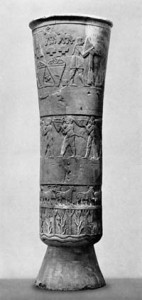 Photograph credit http://www.historyofinformation.com/expanded.php?id=2617
Photograph credit http://www.historyofinformation.com/expanded.php?id=2617
The Warka Vase is made from alabaster, a form of marble, and stands approximately 36 inches high. The piece was found in the Temple Complex of the Sumerian goddess Inanna. Inanna was the patron deity of Uruk and is often mentioned with the other three Mesopotamian deities of Uruk – Anu, Enki, and Enlil. Her name is often accompanied by the symbol of a reed stalk tied in a hook at the top next to it. Inanna was believed to be the goddess of love and war and was later believed to be the goddess of fertility. While Inanna was the goddess of love, she was not the goddess of marriage. She was associated with sexual behavior. In each story that is told about her she is never an innocent bystander. She is always sly, manipulative, “violent and lusting after power“. One of many examples of Inanna’s manipulation can be found in the Epic of Gilgamesh. Gilgamesh was two-thirds god and one-third man, and Ishtar, Inanna’s Akkadian counter-part, fell in love with him the first time she laid eyes on him. “Inanna was carefully identified with Ishtar and rose in prominence from a local vegetative deity of the Sumerian people to the Queen of Heaven and the most popular goddess in all of Mesopotamia”.[i] Gilgamesh did not return the same affection towards her to which she took great offense. Ishtar had her father, Anu, make a divine bull to kill Gilgamesh and his friend Enkidu. Enkidu defeated the bull so the gods punished him by taking his life. Ishtar’s scheme did not go as planned, but someone’s life was still taken because of her selfishness and manipulation.
The Warka Vase tells a narrative story and is said to be a representation of the New Year’s festival. The registers show men, animals, water, and grain, and the New Years festival is believed to have brought fertility and growth to the soil. The bottom register shows a procession of animals walking to the right. The middle register shows nude men carrying vessels walking to the left in the opposite direction of the animals. The top register seems to depict the performance of a sacrifice or offering and shows a bearded bull which often represents deity. The direction switching from left to right gives a sense of movement up to the temple starting from the bottom register of the vase and proceeding to the top register. The male and female figures on the vase, which are no longer in tact, are believed to be depicting Inanna and Dumuzi, or her priestess and the priest-king. “The fusion of the world of the gods and that of the humans was so complete at the end of the fourth millennium, when the vase was produced, that depictions of figures lack indicators of divinity”.[ii] Union between deities and humans was believed an essential step in the process of growth and fertility in Sumer. Cultural wisdom was that the pleasure of deities brought prosperity to the lands.
The interaction between deity and priest-king in the Warka Vase is why the piece was chosen for this digital exhibition. Inanna “…brings knowledge and culture to the city of Uruk” .[iii] She was said to be the source of abundant harvests, power, and protection of the kings.
[i] Joshua J. Mark, “Inanna”, Ancient History Encyclopedia, 2010, http://www.ancient.eu/Inanna/.
[ii] The Metropolitan Museum of Art, Art of the First Cities, (New York: The Metropolitan Museum of Art, 2003), 24.
[iii] Joshua J. Mark, “Inanna”, Ancient History Encyclopedia, 2010, http://www.ancient.eu/Inanna/.
Babylonian Stele of Hammurabi, Made in Babylon, Erected at Sippar, Found in Susa, c. 1792-1750 BCE
 Photograph credit Getty Images http://www.history.com/news/history-lists/8-things-you-may-not-know-about-hammurabis-code
Photograph credit Getty Images http://www.history.com/news/history-lists/8-things-you-may-not-know-about-hammurabis-code
The Stele of Hammurabi is an art piece and code of laws that was found in ancient Susa, and commissioned by Hammurabi, the sixth king of Babylon. The stele is made of diorite and is 7.4 feet tall, which emphasizes its significance. The main purpose of the piece was to serve as political propaganda, reminding those in the towns of Hammurabi’s kingdom of his rule and his laws. While the bottom portion serves as political propaganda the top is a religious relief sculpture paying tribute to Shamash, the sun god. The principle scene depicted shows King Hammurabi receiving his investiture from Shamash.
Hammurabi was the king of Babylon in Mesopotamia from 1792 to 1750 B.C.E. Babylon’s history was made famous because of Hammurabi’s greatness and military prominence. “Hammurabi combined his military and political advances and irrigation projects and the construction of fortifications and temples celebrating Babylon’s patron deity Marduk”.[i] Hammurabi implemented one of the earliest forms of legal codes in ancient Babylon. “His code, a collection of 282 laws and standards, stipulated rules for commercial interactions and set fines and punishments to meet the requirements of justice”.[ii] “An eye for an eye, a tooth for a tooth” is an example of one of the harsh punishments that Hammurabi enforced. Hammurabi’s Code was written in cuneiform script, the earliest system of writing, which was developed by the Sumerians. It is divided into three parts, a prologue, epilogue, and two literary passages describing the 282 laws. The prologue describes King Hammurabi’s role as protector, his empire, and triumph. The epilogue is a lyric and summary of Hammurabi’s legal work and groundwork for the future. The two literary passages were put into layman’s terms so everyone could understand the terms of the laws. The punishments were written as conditional statements, for example, “If a man knock out the teeth of his equal, his teeth shall be knocked out”.
Shamash, the sun god, who is seen in the top half of the stele, was also the god of law and justice, which explains why he is holding a staff and ring. He was an Akkadian god who “exercised the power of light over darkness and evil”.[iii] When comparing the Stele of Hammurabi to the Shamash Stele you can see that there is no division between Hammurabi, the king, and Shamash, the deity. It gives a sense of unification between the two. The Victory Stele of Naram-Sin shows Naram-Sin portraying himself as a god, so in comparing the two, the Stele of Hammurabi holds to the tradition where the king is still the negotiator with the deity and submits to the power of the god.
This piece represents another example of the interaction between the king and patron deity. The king is the middleman who communicates with the deity, presenting the god with worship and gifts. In this case the relationship is also used as political propaganda to ensure that the people of Babylon submit to the Hammurabi code – a legal system implemented “to prevent the strong from oppressing the weak and to see that justice is done to widows and orphans”.[iv]
[i] History.com Staff, “Hammurabi”, 2009, A+E Networks, http://www.history.com/topics/ancient-history/hammurabi.
[ii] History.com Staff, “Hammurabi”, 2009, A+E Networks, http://www.history.com/topics/ancient-history/hammurabi.
[iii] Encyclopædia Britannica Online, s. v. “Shamash”, accessed April 21, 2015, http://www.britannica.com/EBchecked/topic/538274/Shamash.
[iv] History.com Staff, “Hammurabi”, 2009, A+E Networks, http://www.history.com/topics/ancient-history/hammurabi.
Temple Complex at Karnak, c. 1292-1190 BCE
 Photograph credit http://stargate.wikia.com/wiki/Karnak
Photograph credit http://stargate.wikia.com/wiki/Karnak
The Temple Complex at Karnak is found in Thebes on the east bank of the Nile River. The ancient Egyptians knew the temple of Karnak as Ipet-isu—or “most select of places”—.[i] It is considered the largest temple complex on Earth. It pays tribute to the deities Amun (Amun-Ra), Khnosu, and Mut. It is made up of courts ascribed to over 30 different kings, 3 main temple precincts, Hypostyle Hall, the sacred lake, and Scarab statues.
The largest temple in the complex is the Temple of Amun (Amun-Re), the King of the gods. The other two temples are the temples of his wife Mut, and son Khnosu. Amun was one of the most important gods in ancient Egypt, and once united with Ra, the sun god, he was the most powerful. “Amun-Ra was considered to be the father and protector of the pharaoh”.[ii] Six enormous figures sit outside the Temple of Amun that are believed to be the sculptures of the royal family, Hatshepsut and her ancestors. Hastshepsut, the Pharaoh of the 18th Dynasty often associated herself with Amun, and one form of propaganda even said that she was the daughter of Amun.
The Great Hypostyle Hall built by Sety I, the 19th century pharaoh, is the most grand of the buildings at Karnak, even in the presence of the temples of gods and goddesses. The Hall is a 54,000 square feet forest of 134 columns. The columns are 45’ wide and approximately 70’ tall. “Not only does the scale and completeness of this monument remain a rarity among ancient Egyptian temples, but is also the largest and most elaborately decorated of all such buildings in Egypt”.[iii] There is great detail in the relief carvings throughout the hypostyle. “The patchwork of artistic styles and different royal names seen in these inscriptions and relief sculptures reflect the different stages at which they were carved over the centuries”.[iv] Some of the relief’s include; Sety I offering two flowers, Ramesses II offering incense, Ramesses IV offering lettuce to Amun-Ra, Sety I attacking the Syrian town of Kadesh, and Horus with the headdress of Amun and the King.
The Sacred Lake is 393 feet by 252 feet and was dug by Tuthmosis III. The lake represents the remembrance of the void of chaos, memorial witness, and the commencement point of creation. It is a place of purification and is where the priest would bathe himself before sacred rituals. The goose is a symbol of Amun and the sacred geese of Amun also lived in the lake.
The Scarab of Amenhotep III, dung beetle and granite statue, was an emblem of the cycle and nature of creation. The dung beetle was an insect associated with the sun god Khepri. “The plinth is decorated with a lightly inscribed sunk relief scene of a kneeling Amenhotep III offering to Khepri who is seated on a low throne. A winged solar disk extends over their heads”.[v] The Scarab is attached to the sacred lake, almost as if they are standing guard, standing between chaos and the rest of the world.
The Temple Complex at Karnak, filled with sacred buildings and rich culture, holds great significance to Egyptian history. “It is the largest religious building ever made, covering about 200 acres, and was a place of pilgrimage for nearly 2,000 years”.[vi] This virtual exhibit would not have been complete without the Temple Complex at Karnak taking an appropriate place considering the amount of religious ceremonies and practices that took place there.
[i] Owen Jarus, “Karnak: Temple Complex of Ancient Egypt”, 2012, http://www.livescience.com/25184-karnak-temple.html
[ii] J. Hill, “Gods of ancient Egypt: Amun”, 2010, http://www.ancientegyptonline.co.uk/amun.html
[iii]University of Memphis College of Arts & Sciences, “Welcome to the Hypostyle Hall”, http://www.memphis.edu/hypostyle/staff_biographies.htm
[iv] University of Memphis College of Arts & Sciences, “Welcome to the Hypostyle Hall”, http://www.memphis.edu/hypostyle/staff_biographies.htm
[v] C. Zarnoch, E. Sullivan, “Scarab of Amenhotep III”, http://dlib.etc.ucla.edu/projects/Karnak/resource/ObjectCatalog/1854
[vi] Mark Millmore, “Karnak Temple Sacred Lake”, Discovering Egypt Website, 1997, http://discoveringegypt.com/karnak-temple/
Marble metope from the Parthenon, Athens, 447-438 BCE
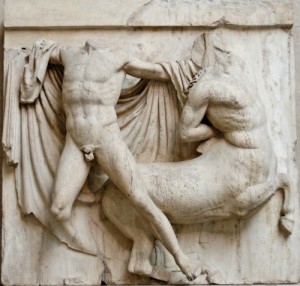 Photograph credit Ancient History Encyclopedia http://www.ancient.eu/article/780/
Photograph credit Ancient History Encyclopedia http://www.ancient.eu/article/780/
The marble metope from the Parthenon was a series of 92 marble panels on the exterior Doric frieze of the Parthenon in Athens. The marble metopes are also known as the Elgin Marbles, named after the 7th Earl of Elgin, Thomas Bruce who sold the marbles to Britain when Greece was under the rule of the Ottoman Empire. The Elgin Marbles still to this day reside in the British Museum, which has led to a rather heated debate. “Britain used to say that Athens had no adequate place to put the Elgin Marbles, the more than half of the Parthenon frieze, metopes and pediments that Lord Elgin spirited off when was ambassador to the ottoman empire two centuries ago”.[i] Now that the Acropolis Museum is a fully functioning museum with state of the art technology to help preserve and restore art, Britain’s argument is invalid. The debate still continues and further questions to whom ownership belongs and whether repatriation is the correct thing to do or not. Art does help define a culture and its ways but do other people deserve see the art too? Would people appreciate art as much if there weren’t places like encyclopedic museums where they can encounter these pieces first hand?
This particular marble metope from the Parthenon depicts a scene of “A fight between a human Lapith and a Centuar”.[ii] Lapith’s were Greek mythological people who lived on Mount Pelion and were known for their rivalry with the Centaurs. Centaurs were creatures that were part human and part horse and descended from Centaurus, the son of the music god, Apollo. The story the scene was taken from was of Centaurs first encounter with wine. The Lapith’s were throwing a marriage feast for their King, Peirithoos, and gave the Centaurs wine. The Centaurs got unruly and their leader, Eurytion, tried to take advantage of the bride. This caused uproar and “a general battle ensued, with the Lapiths finally victorious”.[iii]
This scene is portraying the victory of the Lapith’s over the Centaurs. The nude Lapith male is in the forefront of the sculpture showing dominance. The stance of the Centaur is uncomfortable and like he is in pain, and the stance of the Lapith is more relaxed and over powering. The defeat of the Centaur is shown very clearly on his face, and even though the Lapith is faceless, his body shows his victory. “The composition is perfectly balanced, with the protagonists pulling in opposite directions, around a central space filled by the cascading folds of the Lapith’s cloak”.[iv]
The connection this piece has with this exhibit is that Centaurs are descendants of Appollo’s son, Centaurus, and that Lapith’s are humans derived from greek mythology. In this particular piece there is not a god or goddess being worshiped or offered sacrifices, but the piece gives a sense of how Greek culture was shaped around Greek mythology and the gods. Countless stories were told and art was made to visualize those stories. “The ancient Greek spiritual beliefs, religion, and oral tradition are all reflected and formulated through rich myths and legends that besides entertainment provided an articulation of the moral fiber of the Greek culture as it evolved through at least two thousand years”.[v]
[i] Michael Kimmelman, “Elgin Marble Argument in a New Light”, 2009, New York Times, http://www.nytimes.com/2009/06/24/arts/design/24abroad.html?pagewanted=all&_r=0
[ii] B.F. Cook, The Elgin Marbles, 2nd edition (London, The British Museum Press, 1997)
[iii] B.F. Cook, The Elgin Marbles, 2nd edition (London, The British Museum Press, 1997)
[iv] B.F. Cook, The Elgin Marbles, 2nd edition (London, The British Museum Press, 1997)
[v] Ancient-Greece.org Staff, “Greek Mythology”, http://ancient-greece.org/culture/mythology.html
Laocoon and His Sons Hagesandros, Polydoros, and Athenodoros of Rhodes, Hellenistic Greece, 1st century BCE,
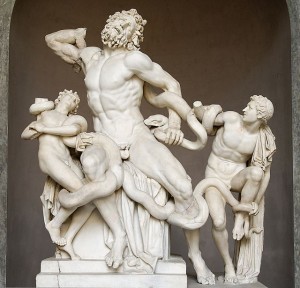 Photograph credit Wikipedia http://en.wikipedia.org/wiki/Laoco%C3%B6n
Photograph credit Wikipedia http://en.wikipedia.org/wiki/Laoco%C3%B6n
This sculpture of Laocoon and His Sons is one of the most famous sculptures from the Hellenistic time period, around 200 BCE. The sculpture was discovered in nine pieces, one seemingly life-sized, by a farmer in his vineyard on Esquiline Hill, was excavated in 1506, and placed in the Vatican where still housed today. The discovery of Laocoon sparked the imaginations of artists from Raphael to Michelangelo, becoming the standard for aesthetic beauty in art for the next several centuries. One can certainly see the influence of this piece on the physical attributes of some of the works of Michelangelo such as many figures on the Sistine Chapel Ceiling with similar muscular structure, and on the emotional attributes of pieces like his Slaves sculptures. Politicians sought after the sculpture as well, and Napoleon even captured the piece for his Louvre for a time. Eventually Laocoon was returned to the Vatican. Standing around eight feet tall, Lacoon and His Sons is sculpted from marble. The sculpture illustrates the scene of Laocoon and his two sons being attacked by sea serpents.
Laocoon was a Trojan priest and was said to be the priest of Poseidon. Some say he was also the priest of the god Apollo. The Trojan War could have been prevented if the Trojans had listened to Laocoon the day the Greeks brought the Trojan horse into the city. Laocoon tried to warn them against bringing the horse into the city because he sensed that it was a trap and indeed it was. Athena, the goddess, was the protector of the Greeks and punished Laocoon for trying to interfere with their plan. She punished him by sending two sea serpents, Porces and Chariboea, to attack his two sons and him. Another narrative says that, “Laocoon offended Apollo by breaking his oath of celibacy and begetting children or by having sexual intercourse with his wife in Apollo’s sanctuary”.[i] Apollo sent two serpents to kill Laocoon and his sons while he was sacrificing a bull at Poseidon’s altar. Whichever tale is true, both stories show that the gods and goddesses interacted with humans regularly but were not always trustworthy and did not always fight on the side of the humans.
The musculature in this sculpture shows the idealized body type of Grecian males during this time period of ancient Greece. The males were warriors and were expected to be the most fit. This piece shows a very intense narrative moment and emphasizes this by exaggerated tension in the bodies. One son seems to be breaking free of the grip of the sea serpents when he looks across to see his father and brother in the agony of their deaths.
This piece was chosen for this exhibit because of the relationship between Laocoon and the gods and goddesses, which also once again illustrates how gods and goddesses were part of everyday life in Greek culture, and for its influence on generations of artists centuries after the original sculpture was made.
[i] The Editors of Encyclopaedia Britannica, “Laocoon, Greek Mythology”, accessed April 21, 2015, http://www.britannica.com/EBchecked/topic/538274/Shamash.
Statuette of Isis and Horus, Ptolemic Period, ca. 304-30 BCE
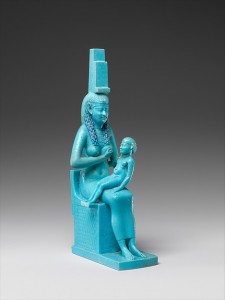 Photograph credit The Metropolitan Museum of Art
Photograph credit The Metropolitan Museum of Art
Isis was arguably the most important goddess of ancient Egyptian history as she was worshipped not only in Egypt, but also throughout Italy and Greece, and her influence lasted long after the demise of the Egyptian empire. The Statuette of Isis and Horus was made of Egyptian faience, the oldest type of ceramic glaze, created by the Egptians. “Faience was made by grinding quartz or sand crystals together with various amounts of sodium, potassium, calcium, magnesium, and copper oxide”.[i] This particular statue of Isis and Horus was approximately seven inches high. This piece was one of many statues of Isis nursing Horus. The other figures were mostly made of bronze, like a majority of other statues and figures of deities during this time period.
Isis nursing her son Horus was seen as a sort of symbol of rebirth for the ancient Egyptians. During this time period deities were often placed in temples and “the most important was the triad (a group of three persons) of Osiris, his wife, Isis, and their son Horus. They represented the king of the dead, the divine mother, and the living king respectively, together they were the perfect family”.[ii] Osiris was the god of the earth and vegetation. His wife, Isis, was also his sister and she was the goddess of the sky. Their son Horus was the god with whom the Egyptian kings associated themselves, and he became a very prominent god. “As a child, Horus was known as Harpokrates, “the infant Horus”. And was portrayed as baby being suckled by Isis”.[iii] His birth was significant because he was conceived after the death of his father, Osiris. The story is told that his mother, Isis, reassembled all of Osiris’s parts so that she could conceive a successor for the throne.
Horus is suckling Isis in this piece, which is why the statue is sometimes referred to as the Divine Mother nursing her infant. Isis is seated on a throne and is holding Horus’s head in her hands. Horus is not clothed and on the right side of his head is a single lock of hair. The object on top of Isis’s head is a throne hieroglyph that represents her name.[iv]
This piece has been replicated and recreated in many different forms throughout history, which confirms its importance and significance in Egypt as well as other cultures. “During later periods, Egyptians produced many small bronze statuettes of their deities, which they then gave as tributes during pilgrimages of holy sites”.[v] Figures were placed in temples as a representation of the gods and goddesses being worshipped and given offerings. The gods and goddesses of Ancient Egypt shaped the culture more and more during the later periods, and Isis influenced religious worship for centuries after her death and even after the end of the Egyptian empire.
[i] Joshua J. Mark, “Faience”, Ancient History Encyclopedia, 2010, http://www.ancient.eu/Faience/
[ii] British Museum of Art Staff, “Bronze figure of Isis and Horus”, http://www.britishmuseum.org/explore/highlights/highlight_objects/aes/b/bronze_figure_of_isis__horus.aspx
[iii] Egyptian Myths Staff, “Horus”, http://www.egyptianmyths.net/horus.htm
[iv] British Museum of Art Staff, “Bronze figure of Isis and Horus”, http://www.britishmuseum.org/explore/highlights/highlight_objects/aes/b/bronze_figure_of_isis__horus.aspx
[v] The Louve Staff, “Statuette: Isis Nursing Horus”, http://www.louvre.fr/en/oeuvre-notices/statuette-isis-nursing-horus
The Amphipolis Mosaic, 4th Century BCE
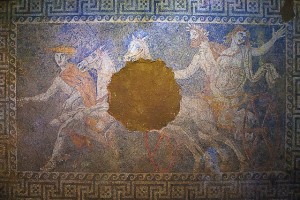 Photograph Credit Hellenic Ministry of Culture. Graphics and analysis © ancient-greece.org
Photograph Credit Hellenic Ministry of Culture. Graphics and analysis © ancient-greece.org
The final piece chosen for this digital exhibition is The Amphipolis Mosaic. Archeologists found the Amphipolis floor Mosaic in 2014 in a tomb in Amphipolis, Macedonia, Greece. This piece was chosen because of its mysteriousness and for the very different artistic techniques used in creating the piece in comparison to other art of this time period. The Amphipolis Mosaic measures ten feet wide and fiftenn feet long and is constructed of white, black, blue, red, yellow, and grey pebbles. The tomb in which the mosaic was found is believed to have been under the rule of Alexander the Great at the time the piece was constructed, and could have been the site where his mother, Olympias, was buried. Although there is conflicting evidence suggesting other possibilities for who is buried in the tomb, Alexander wanted to make his mother a goddess, and she held tremendous political power even after his death, so a tomb of this kind would have been a fitting burial place for such a prominent figure.
The scene depicted “is identified as Hades in the process of carrying Persephone, with a lamenting female figure (Demeter) left behind”.[i] Pluto, whose earlier name was Hades, was in love with Persephone and abducted her to make her his queen. Persephone, also known as Kore, the goddess of the harvest, was the only child of Zeus and Demeter, the goddess of nature. Pluto, or Hades, was the god of the underworld, hell. Hades fell in love Persephone one day when he traveled above ground and saw her picking flowers in a field. One story says that Zeus, the brother of Hades and Persephone’s father, was his cohort and that they trapped her by causing the ground underneath her to split in half. “Persephone slipped beneath the Earth and Hades stole her to the Underworld where he made her his wife”.[ii]
The figure leading the chariot is believed to be Hermes, the god of transitions and boundaries. This would make sense considering this scene is a depiction of the subjects traveling from Earth back to the underworld. As the son of Zeus, the depiction of Hermes leading the chariot also becomes more plausible. Hades is driving the chariot and some say the female figure is Demeter being left behind. However, a better assumption might be that the female figure is actually Persephone herself, judging by the agony on her face and somber wave. Regardless of who the figure is, the raw emotion on the face of the female figure allows a deeper level of connection with the piece of art. The detail and different approach to this piece is what makes it so unique and one of the reasons why it was chosen for this exhibition. Artists during this time period were making bronze figures and marble sculptures, not mosaic pieces from marble. Although it is only a two-dimensional work of art, the detail and scale give great emphasize to the scene of Hades abducting Persephone and bring it to life. “The artist enhances the story with simple gestures and lines, which create a cinematic approach where the viewer has caught a fleeting glimpse of a continuous action in a space and time”.[iii] The piece again reflects the theme of the exhibit as it beautifully shows the connection between art and religion in ancient times.
[i] Ancient-Greece Staff, “Amphipolis Mosaic”, http://ancient-greece.org/art/amphipolis-mosaic.html
[ii] “The Myth of Hades and Persephone”, http://www.greekmyths-greekmythology.com/myth-of-hades-and-persephone/
[iii] Ancient-Greece Staff, “Amphipolis Mosaic”, http://ancient-greece.org/art/amphipolis-mosaic.html
By Carly Strickland
Work Cited
Joshua J. Mark, “Inanna”, Ancient History Encyclopedia, 2010, http://www.ancient.eu/Inanna/.
The Metropolitan Museum of Art, Art of the First Cities, (New York: The Metropolitan Museum of Art, 2003), 24.
History.com Staff, “Hammurabi”, 2009, A+E Networks, http://www.history.com/topics/ancient-history/hammurabi.
Encyclopædia Britannica Online, s. v. “Shamash”, accessed April 21, 2015, http://www.britannica.com/EBchecked/topic/538274/Shamash.
Owen Jarus, “Karnak: Temple Complex of Ancient Egypt”, 2012, http://www.livescience.com/25184-karnak-temple.html
Hill, “Gods of ancient Egypt: Amun”, 2010, http://www.ancientegyptonline.co.uk/amun.html
University of Memphis College of Arts & Sciences, “Welcome to the Hypostyle Hall”, http://www.memphis.edu/hypostyle/staff_biographies.htm
Zarnoch, E. Sullivan, “Scarab of Amenhotep III”, http://dlib.etc.ucla.edu/projects/Karnak/resource/ObjectCatalog/1854
Mark Millmore, “Karnak Temple Sacred Lake”, Discovering Egypt Website, 1997, http://discoveringegypt.com/karnak-temple/
Michael Kimmelman, “Elgin Marble Argument in a New Light”, 2009, New York Times, http://www.nytimes.com/2009/06/24/arts/design/24abroad.html?pagewanted=all&_r=0
B.F. Cook, The Elgin Marbles, 2nd edition (London, The British Museum Press, 1997)
Ancient-Greece.org Staff, “Greek Mythology”, http://ancient-greece.org/culture/mythology.html
The Editors of Encyclopaedia Britannica, “Laocoon, Greek Mythology”, accessed April 21, 2015, http://www.britannica.com/EBchecked/topic/538274/Shamash.
Joshua J. Mark, “Faience”, Ancient History Encyclopedia, 2010, http://www.ancient.eu/Faience/
British Museum of Art Staff, “Bronze figure of Isis and Horus”, http://www.britishmuseum.org/explore/highlights/highlight_objects/aes/b/bronze_figure_of_isis__horus.aspx
Egyptian Myths Staff, “Horus”, http://www.egyptianmyths.net/horus.htm
The Louve Staff, “Statuette: Isis Nursing Horus”, http://www.louvre.fr/en/oeuvre-notices/statuette-isis-nursing-horus
Ancient-Greece Staff, “Amphipolis Mosaic”, http://ancient-greece.org/art/amphipolis-mosaic.html
“The Myth of Hades and Persephone”, http://www.greekmyths-greekmythology.com/myth-of-hades-and-persephone/